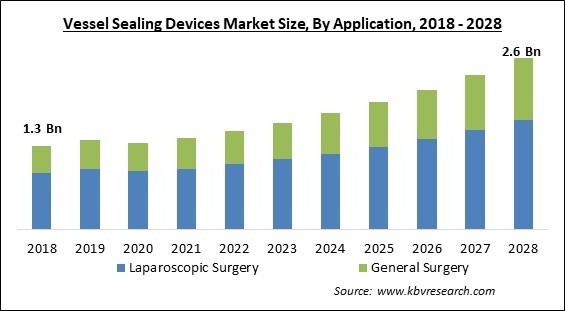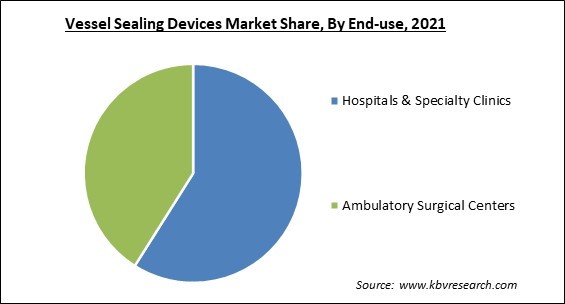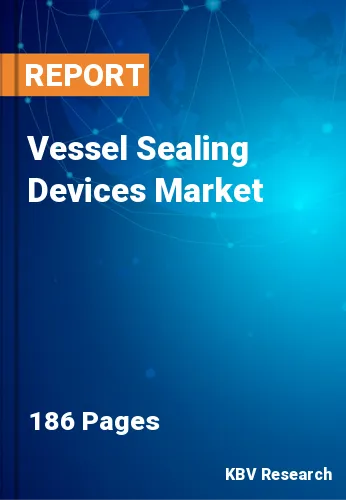The Global Vessel Sealing Devices Market size is expected to reach $2.6 billion by 2028, rising at a market growth of 9.7% CAGR during the forecast period.
By totally occluding the blood vessel and denaturing the collagen and elastin in the vessel wall, vessel sealing devices are utilized to seal the vessel wall. The most popular energy-based surgical instruments include hybrid, ultrasonic, and bipolar.

In both open and laparoscopic operations, energy-based vascular sealing devices (VSDs) have been created to speed up dissection and hemostasis. With less blood loss and shorter operating periods, these technologies allow surgeons to increase the effectiveness and safety of surgeries. In modern medicine, there is a constant demand for technological advancement to manufacture high-quality VSDs with more accurate vascular sealing quality and less heat harm to surrounding tissues.
Traditional monopolar devices have increased lateral heat spread and uncertain, weak vessel sealing. The two types of hemostatic energy devices that are most frequently employed in modern surgical practice are bipolar and ultrasonic ones.
Modern bipolar devices stop electric current from spreading through the device's jaws, sealing blood vessels and minimizing damage to the tissues around them with electrothermal energy. In contrast, ultrasonic devices use high-frequency vibrations rather than electrical current, but the energy can only be transmitted very thinly between the device's jaws.
Movement restrictions were implemented, and the majority of countries went into lockdown as academic societies and regulatory authorities advised delaying elective surgical procedures. All of this led to a decline in the demand for vessel sealing devices. It is anticipated that laparoscopic device procedures would return to normal as the COVID-19 pandemic's recovery phase gets underway. Additionally, the COVID-19 pandemic promoted the use of disposable laparoscopic instruments. Cross-contamination is prevented by single-use laparoscopic instruments, which proved to be an advantageous circumstance for their use throughout the COVID-19 pandemic. As a result, the market for vessel sealing devices has quickly recovered since the pandemic.
The demand for minimally invasive vessel sealing devices has been driven by the rise in gynecological, urological, cardiology, orthopedic, and general surgery needs. A continuous vessel-sealing device workflow is delivered through the development of new software and sophisticated vessel-sealing devices, allowing the surgeon to do quick, accurate, painless surgeries with increased efficiency.
Compared to traditional open surgeries, minimally invasive surgeries are significantly less frightening. Traditional procedures carried out using standard laparoscopic tools can be difficult and distressing. The procedure is carried out with the assistance of specialized, smaller equipment and minimally invasive laparoscopic cameras that are placed through smaller incisions. After minimally invasive operations, patients can recover more quickly and with less pain. The market for vessel sealing devices may expand as minimally invasive operations become more popular.
Despite the many advantages of vessel sealing systems, some disadvantages can prevent the industry from expanding. Vessel sealing methods can damage nerves, ureters, and bowels as a result of lateral thermal energy distribution. 2 mm of tissue is damaged by this lateral energy dispersion. In a 2020 essay, Shosaburo Oyama said that LigaSure could lead to surgical difficulties. Due to the inability of thick, dense tissues to fit between blades, LigaSure is unable to clamp vital blood vessels and nerves. It is anticipated that issues with vessel sealing devices may hinder the business.
On the basis of Application, the Vessel Sealing Devices Market is divided into Laparoscopic Surgery and General Surgery. In the market for vessel sealing devices in 2021, the general surgery sector accounted for a sizeable revenue share. This is due to the fact that it is frequently chosen in procedures like sigmoidectomies and appendectomies. This preference may be explained by the superior success rate of these procedures over laparoscopy. General procedures have a small market share due to their high price and extended post-operative hospital stay.

Based on the product, the vessel sealing devices market is divided classified into generators, instruments, and accessories. In 2021, the generators market segment showcased the significant revenue share in the vessel sealing industry. Bipolar and vessel sealing treatments are powered by electrosurgical generators, also referred to as vessel sealing generators. Energy devices are increasingly used in minimally invasive surgery for vessel sealing and dissection. These generators give accurate energy and electrode pressure to vessels for a predefined period of time in order to accomplish a full and long-lasting fusion of the vessel lumen.
Based on End-use, the market for vessel sealing devices is segmented into ambulatory surgery centers, hospitals, and specialized clinics. The market for vessel sealing devices in 2021 saw the biggest revenue share in the hospital sector. This is a result of more procedures being carried out in hospital settings. Reusable vessel sealing systems, in particular, provide end users with greater effectiveness and cost savings. Compared to disposable devices, reusable vascular sealing devices used during modified total neck dissection operations can dramatically lower medical expenses.
| Report Attribute | Details |
|---|---|
| Market size value in 2021 | USD 1.4 Billion |
| Market size forecast in 2028 | USD 2.6 Billion |
| Base Year | 2021 |
| Historical Period | 2018 to 2020 |
| Forecast Period | 2022 to 2028 |
| Revenue Growth Rate | CAGR of 9.7% from 2022 to 2028 |
| Number of Pages | 186 |
| Number of Tables | 330 |
| Report coverage | Market Trends, Revenue Estimation and Forecast, Segmentation Analysis, Regional and Country Breakdown, Companies Strategic Developments, Company Profiling |
| Segments covered | Product, Application, End-use, Region |
| Country scope | US, Canada, Mexico, Germany, UK, France, Russia, Spain, Italy, China, Japan, India, South Korea, Singapore, Malaysia, Brazil, Argentina, UAE, Saudi Arabia, South Africa, Nigeria |
| Growth Drivers |
|
| Restraints |
|
By geography, the vessel sealing devices market is categorized into North America, Europe, Asia Pacific, and LAMEA. In 2021, the North American region dominated the vessel sealing devices market. The presence of significant firms and hospitals with cutting-edge technology in the United States and Canada accounts for the region's considerable market share. Additionally, the rising prevalence of chronic medical disorders in the US as a result of bad eating habits, a desire for quick-to-prepare snacks, a lack of exercise, a stressful lifestyle, and a sizable older population is encouraging market expansion.
Free Valuable Insights: Global Vessel Sealing Devices Market size to reach USD 2.6 Billion by 2028
The market research report covers the analysis of key stake holders of the market. Key companies profiled in the report include Medtronic PLC, Olympus Corporation, B. Braun Melsungen AG, Johnson & Johnson, Intuitive Surgical, Inc., Hologic, Inc. (Bolder Surgical), Erbe Elektromedizin GmbH, BOWA-electronic GmbH & Co. KG, OmniGuide, Inc., and KLS Martin Group.
By Application
By End Use
By Product
By Geography
The global Vessel Sealing Devices Market size is expected to reach $2.6 billion by 2028.
New Technologies To Drive The Global Market are driving the market in coming years, however, Problems With Using Vessel Sealing Devices restraints the growth of the market.
Medtronic PLC, Olympus Corporation, B. Braun Melsungen AG, Johnson & Johnson, Intuitive Surgical, Inc., Hologic, Inc. (Bolder Surgical), Erbe Elektromedizin GmbH, BOWA-electronic GmbH & Co. KG, OmniGuide, Inc., and KLS Martin Group.
The Laparoscopic Surgery segment acquired maximum revenue share in the Global Vessel Sealing Devices Market by Application in 2021 thereby, achieving a market value of $1.7 billion by 2028.
The North America market dominated the Global Vessel Sealing Devices Market by Region in 2021, and would continue to be a dominant market till 2028; thereby, achieving a market value of $1.1 billion by 2028.
Our team of dedicated experts can provide you with attractive expansion opportunities for your business.

